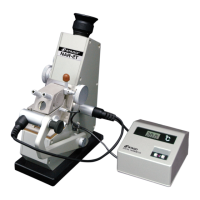32
9. Measurement of solid sample
Fig. 9-13
(3)-4 Measurement
Set the sample piece a on the main
prism. For detail of setting and lighting,
refer to the procedure for glass, plastic
and film samples. Since the polarizing
eyepiece can be revolved, turn it to
change the polarization direction. The
polarization direction is indicated by the
point marking as shown in Fig. 9-13.
a)
To measure Refractive Index in the Z axis, set the point mark at the topmost position .
To measure Refractive Index in the X axis, set the point mark sideways (Fig. 9-12).
Then, set the sample piece b on the main prism. When the polarizing eyepiece is set
at the topmost position, the sample piece b can be measured for the Refractive Index
in the Z axis. On the other hand, when the polarizing eyepiece is set sideways, the
sample can be measured for the Refractive Index in the Y axis.
Refractive Index of the Z axis will be obtained in two ways, namely, measurement
result with the sample piece a and that with the sample piece b. Either of the results
can be adopted. If there is a difference between two measured values with the
samples a and b, adopt an average value of the two.
ە
b)
ە
Setting orientation of sample and polarizing eyepiece
Measuring
direction
Thickness
direction
(Z axis)
Thickness
direction
(Z axis)
Machining
direction
(Y axis)
Right angle to
machining
direction
(X axis)
Measuring
sample
a a b b
Setting orientation
of polarizing
eyepiece
(ࠉexpresses
Polarizing
direction.)
Setting orientation
of double
refractive sample
(ࠉexpresses the
Machining direction
ࠝY axisࠞ)
Light
Light Light Light
Fig. 9-12
Point marking
Polarizing direction
(3)-5 Lighting
For measuring Refractive Index of film sample, make sure to use a D-line (589nm)
light source such as a sodium lamp and so on to illuminate the sample stably with a
monochromatic light as well as to prevent measurement from getting influenced by
diffused light and diffusion reflection.
Note:
In the case of using LED lamp (approximating to wavelength of D-line) of NAR-2T,
turn the color compensator knob and stop turning when the boundary line becomes
neither reddish nor bluish.

